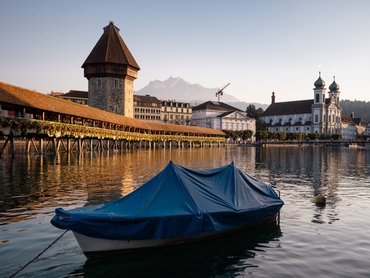Übersicht
On our festival tour, the programme includes a work that offers plenty to discover while also being an absolute classical favourite: Bedřich Smetana’s My Fatherland, a musical picture-gallery of Czech myths and landscapes. Of course, most people have heard the second movement, The Vltava. But the other sections? They are equally captivating! And between the lines, they narrate the tale of an entire nation’s voyage of self-discovery. Here are the most important facts in brief.
1. Gradual triumph
Prague, 5 November, 1882: Smetana’s My Fatherland is performed in its entirety for the first time. Individual movements had already been heard in concert, and sheet music editions were also circulating. The audience had some sense of what kind of masterpiece would follow, and the excitement was palpable: “Not since the opening of the National Theatre had there been such an exalted, festive atmosphere in a gathering of Czechs,” reported one observer. They were not disappointed: Smetana’s premiere was an unprecedented triumph.
2. Bedřich or Friedrich?
The founder of Czech national music must surely be a Czech! Or not? In Smetana’s case, the answer is a resounding yes and no. Bohemia is a multi-ethnic state, with Germans and Czechs forming the two largest population groups. And Smetana feels more or less German until the age of 24. He calls himself Friedrich, and barely speaks Czech. This only changes with an experience that was decisive, both for the composer and for the Bohemian nation: the Prague Whitsun Uprising of 1848.
3. Composer and revolutionary
Like the Poles and Hungarians shortly before them, the Czechs are also striving for national independence. And they take to the streets, demonstrate and rebel. But the revolution is bloodily suppressed. The result: 43 dead and 63 injured. Friedrich Smetana is in the thick of it, experiences the events at close quarters, and is transformed. He shows solidarity, wants to be Czech, changes his name to Bedřich, and writes his first Czech songs. He is now part of the movement: Bohemia, the breeding-ground for his later compositions, should be free .

4. Women in charge!
Women play a leading role in Bohemian mythology. Vyšehrad Castle, to which Smetana dedicates the first movement of his tone poem, is the home of Princess Libuše, the “mother of the Czech nation”. In a vision, she predicts the founding of Prague and prophesies a rosy future for her people’s heroes. After Libuše’s death, a battle for the rule of Bohemia breaks out. Amongst the protagonists: Šárka, from Libuše’s entourage. Šárka and her army of women defeat their male enemies with a trick that Smetana depicts in his third movement: she seduces the enemy commander, and gets him and his fighters drunk. At this point, the women attack, surprising the men; a gory slaughter ensues.
5. “The Vltava”: Unforgettable yet inaudible
The catchiest tune of this symphonic poem comes between these two movements. A piece that is featured in almost every “best of classical music” compilation, it vividly traces the course of the Vltava. Smetana sets the flow to music with motifs that conjure gurgling and rippling, waves and billows - textbook tone-painting. The musical waves of this Vltava burst their banks, spreading Smetana’s name to all corners of the world. But for the tinnitus-stricken composer, it is a success with a bitter aftertaste. At the end of his autograph, he notes: “I am completely deaf.” He will never hear his greatest hit himself.
6. Between hope and protest
This makes the work all the more beloved among the Czech population - and with lasting effect. Composed as a soundtrack to the “national rebirth”, it is still played in the Czech Republic on a wide variety of occasions. The state uses it as ceremonial music, the radio as a signature tune. In the Mauthausen concentration camp, the melodies were played as a sign of protest; during the Prague Spring, as a sign of hope. My homeland signifies struggle, triumph, and national independence.
7. Smetana everywhere
Anyone travelling to the Czech Republic today cannot avoid Smetana. There are larger-than-life statues of Smetana in many cities, and a museum and concert hall have been dedicated to him in Prague. Also of significance is the Prague Spring Festival, which opens every year on 12 May, the anniversary of Smetana’s death, with My Fatherland (this year performed by the Berliner Philharmoniker and Kirill Petrenko). And Smetana can also be found in the night sky: through an asteroid and a crater on the planet Mercury that bear his name.

